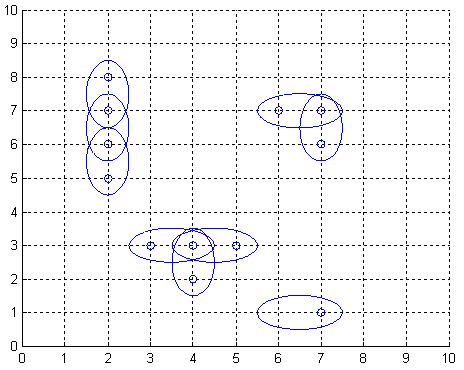poj 3020 Antenna Placement 二分图
来源:互联网 发布:英雄联盟网络延迟高 编辑:程序博客网 时间:2024/06/07 00:43
Antenna Placement
Time Limit: 1000MS Memory Limit: 65536KTotal Submissions: 7223 Accepted: 3591
Description
The Global Aerial Research Centre has been allotted the task of building the fifth generation of mobile phone nets in Sweden. The most striking reason why they got the job, is their discovery of a new, highly noise resistant, antenna. It is called 4DAir, and comes in four types. Each type can only transmit and receive signals in a direction aligned with a (slightly skewed) latitudinal and longitudinal grid, because of the interacting electromagnetic field of the earth. The four types correspond to antennas operating in the directions north, west, south, and east, respectively. Below is an example picture of places of interest, depicted by twelve small rings, and nine 4DAir antennas depicted by ellipses covering them.

Obviously, it is desirable to use as few antennas as possible, but still provide coverage for each place of interest. We model the problem as follows: Let A be a rectangular matrix describing the surface of Sweden, where an entry of A either is a point of interest, which must be covered by at least one antenna, or empty space. Antennas can only be positioned at an entry in A. When an antenna is placed at row r and column c, this entry is considered covered, but also one of the neighbouring entries (c+1,r),(c,r+1),(c-1,r), or (c,r-1), is covered depending on the type chosen for this particular antenna. What is the least number of antennas for which there exists a placement in A such that all points of interest are covered?

Obviously, it is desirable to use as few antennas as possible, but still provide coverage for each place of interest. We model the problem as follows: Let A be a rectangular matrix describing the surface of Sweden, where an entry of A either is a point of interest, which must be covered by at least one antenna, or empty space. Antennas can only be positioned at an entry in A. When an antenna is placed at row r and column c, this entry is considered covered, but also one of the neighbouring entries (c+1,r),(c,r+1),(c-1,r), or (c,r-1), is covered depending on the type chosen for this particular antenna. What is the least number of antennas for which there exists a placement in A such that all points of interest are covered?
Input
On the first row of input is a single positive integer n, specifying the number of scenarios that follow. Each scenario begins with a row containing two positive integers h and w, with 1 <= h <= 40 and 0 < w <= 10. Thereafter is a matrix presented, describing the points of interest in Sweden in the form of h lines, each containing w characters from the set ['*','o']. A '*'-character symbolises a point of interest, whereas a 'o'-character represents open space.
Output
For each scenario, output the minimum number of antennas necessary to cover all '*'-entries in the scenario's matrix, on a row of its own.
Sample Input
27 9ooo**oooo**oo*ooo*o*oo**o**ooooooooo*******ooo*o*oo*oo*******oo10 1***o******
Sample Output
175
Source
Svenskt Mästerskap i Programmering/Norgesmesterskapet 2001
题意就是有长度为2的两个点,问最少需要几个能全部覆盖
求最小路径覆盖
最小路径覆盖=顶点数-最大匹配
证明:
1 如果匹配数为0,那么图中没有边,需要n条路径
2 如果a,b之间连一条边,那么匹配数增1,需要的路径数会减少一,因为a,b之间只需要一条,那么就证明了
我的code中 最大匹配求的是双向的,所以/2#include <iostream>#include <stdio.h>#include <algorithm>#include <stdlib.h>#include <math.h>#include <string.h>#include <vector>#include <map>#include <set>#include <queue>#include <stack>using namespace std;#define Max 500int T;int cx[Max],cy[Max],w,h,grid[Max][Max],v1,v2,vis[Max],cnt;int mp[Max][Max];char t;int xn[5]={0,-1,0,1,0};int ynn[5]={0,0,1,0,-1};bool dfs(int u){for(int v=1;v<=v2;v++){if(grid[u][v]&&!vis[v]){vis[v]=1;if(cy[v]==0||dfs(cy[v])){cx[u]=v;cy[v]=u;return true;}}}return false;}int main(){cin>>T;while(T--){cin>>h>>w;v1=v2=cnt=0;memset(grid,0,sizeof(grid));memset(cx,0,sizeof(cx));memset(cy,0,sizeof(cy));memset(mp,0,sizeof(mp));for(int i=1;i<=h;i++){for(int j=1;j<=w;j++){cin>>t;if(t=='*')mp[j][i]=++cnt;}}for(int j=1;j<=h;j++){for(int i=1;i<=w;i++){if(mp[i][j]!=0)for(int k=1;k<=4;k++){int xx=i+xn[k];int yy=j+ynn[k];if(xx>=1&&xx<=w&&yy>=1&&yy<=h){if(mp[xx][yy]){grid[mp[i][j]][mp[xx][yy]]=1;}}}}}int res=0;v1=v2=cnt;for(int i=1;i<=v1;i++){memset(vis,0,sizeof(vis));if(dfs(i))res++;}cout<<cnt-res/2<<endl;}return 0;} 0 0
- poj 3020 Antenna Placement 二分图匹配
- poj 3020 Antenna Placement 二分图
- poj 3020 Antenna Placement 二分图匹配
- poj-3020-Antenna Placement-二分图
- Antenna Placement poj 3020 二分图
- 【二分图】poj 3020 Antenna Placement
- 【二分图+最小路径覆盖】北大 poj 3020 Antenna Placement
- poj 3020 Antenna Placement(二分图匹配)
- POJ 3020Antenna Placement(二分图最小顶点覆盖)
- poj 3020 Antenna Placement 二分图最小路径覆盖
- poj 3020 Antenna Placement(二分无向图 匈牙利)
- POJ 3020 Antenna Placement ,二分图的最小路径覆盖
- POJ 3020 Antenna Placement(二分图的最大匹配)
- POJ 3020 Antenna Placement(二分图匹配)
- POJ 题目3020 Antenna Placement(二分图)
- POJ - 3020 Antenna Placement 二分图 最小路径覆盖
- Poj 3020 Antenna Placement (二分图最小路径覆盖)
- POJ 3020 Antenna Placement(二分图最小路径覆盖)
- Windows ubuntu双系统 重装Windows后重新引导ubuntu
- Android Studio Rendering Problems不能显示xxx.xml布局文件
- 11. 撤销修改
- 日经春秋 20150616
- linux命令二:chgrp
- poj 3020 Antenna Placement 二分图
- Python 在线反编译工具
- Extjs Grid 中文排序
- 【第二章】 IoC 之 2.1 IoC基础 ——跟我学Spring3
- IOS Key-Value Observing (KVO)
- linux防火墙iptables详细教程
- 使用.bat批处理文件开机自动启动程序
- 使用JDBC连接MySQL数据库--典型案例分析(七)----批量插入员工信息
- 计算机是如何启动的?


